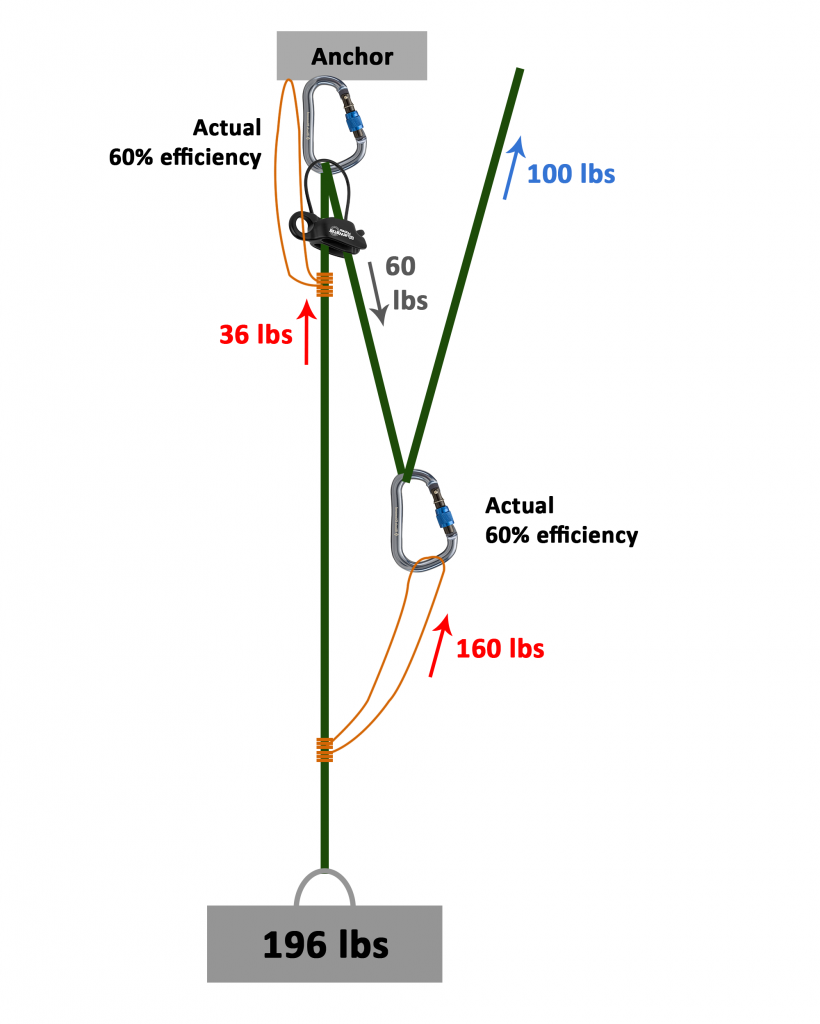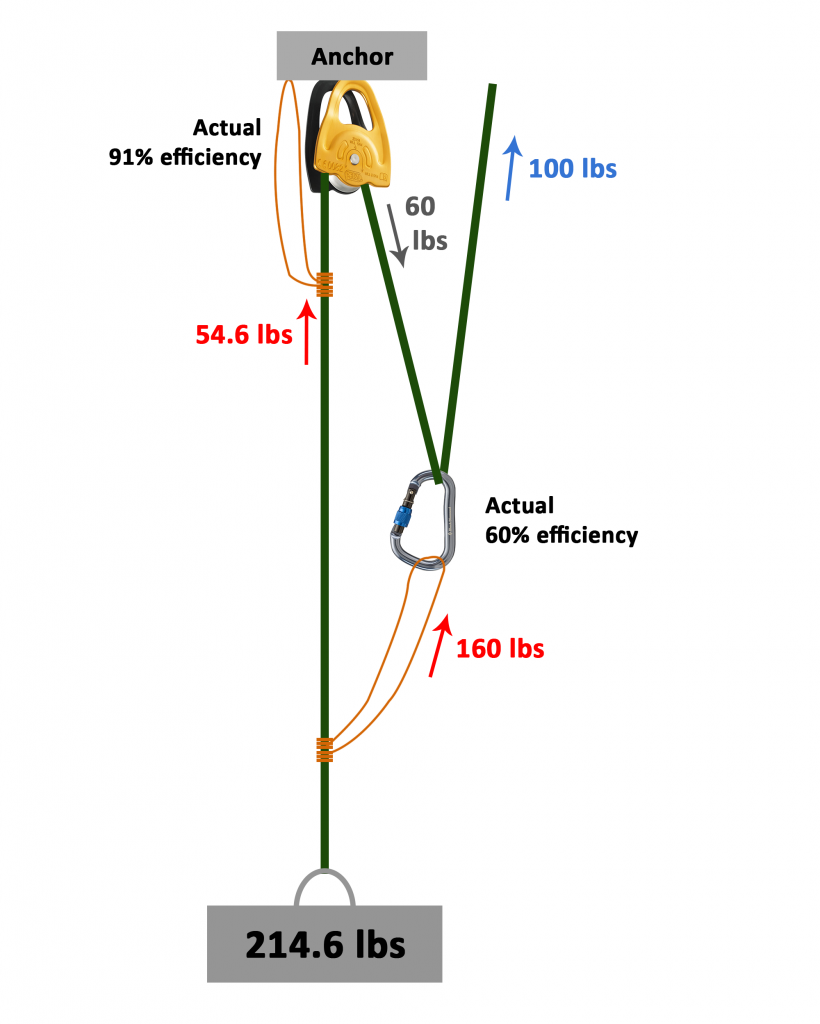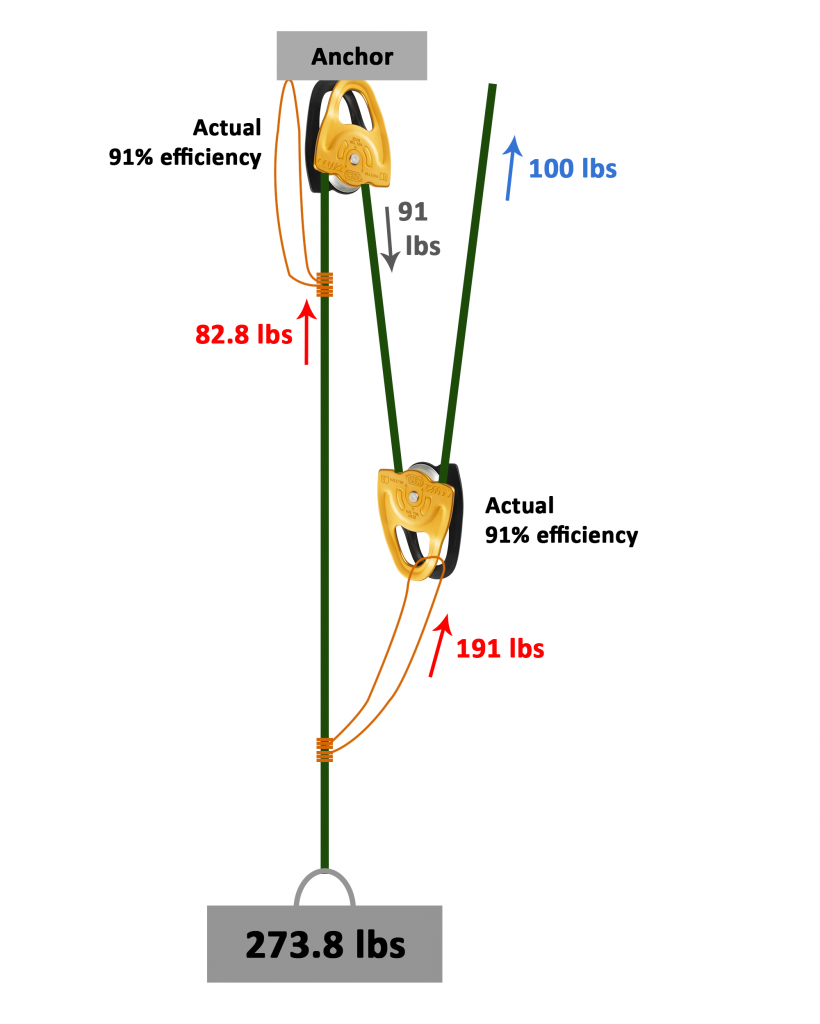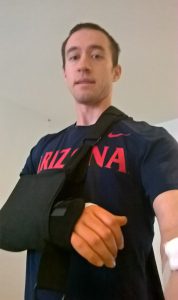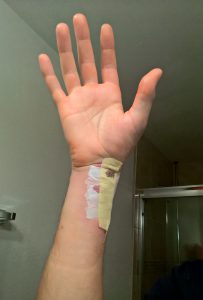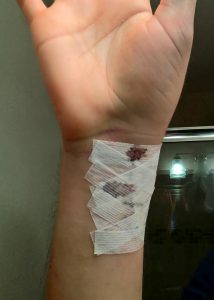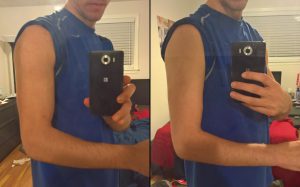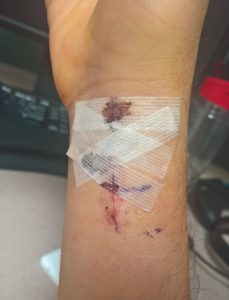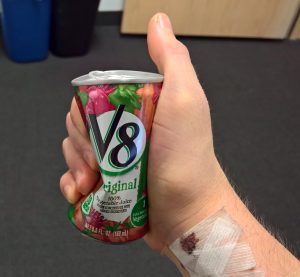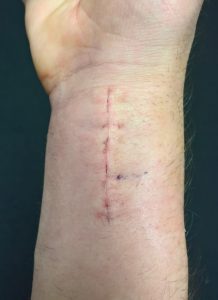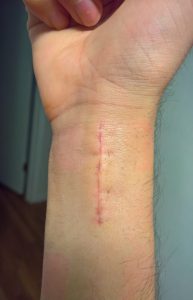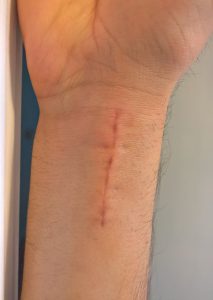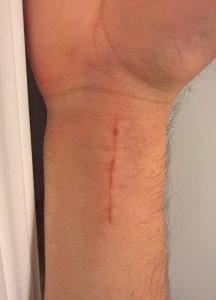On July 14th, my wife and I both fell 15 feet at the first pitch of Le Petit Cheval – Spontaneity Arete, in Washington Pass, North Cascades, Washington. We hope to share our experience to help make others safer. Luckily, we didn’t fall any further, we were prepared (SOS beacon), and we didn’t suffer any permanent injuries.
Events leading up to the fall
Alexis and I had just reached pitch 1 of Le Petit Cheval. There were no photos on Mountain Project of the first pitch, so we weren’t sure exactly where it starts.
We were unknowingly at the start of pitch 1, which starts with a class 4 / low class 5 section of 10 vertical feet that leads to another ledge.
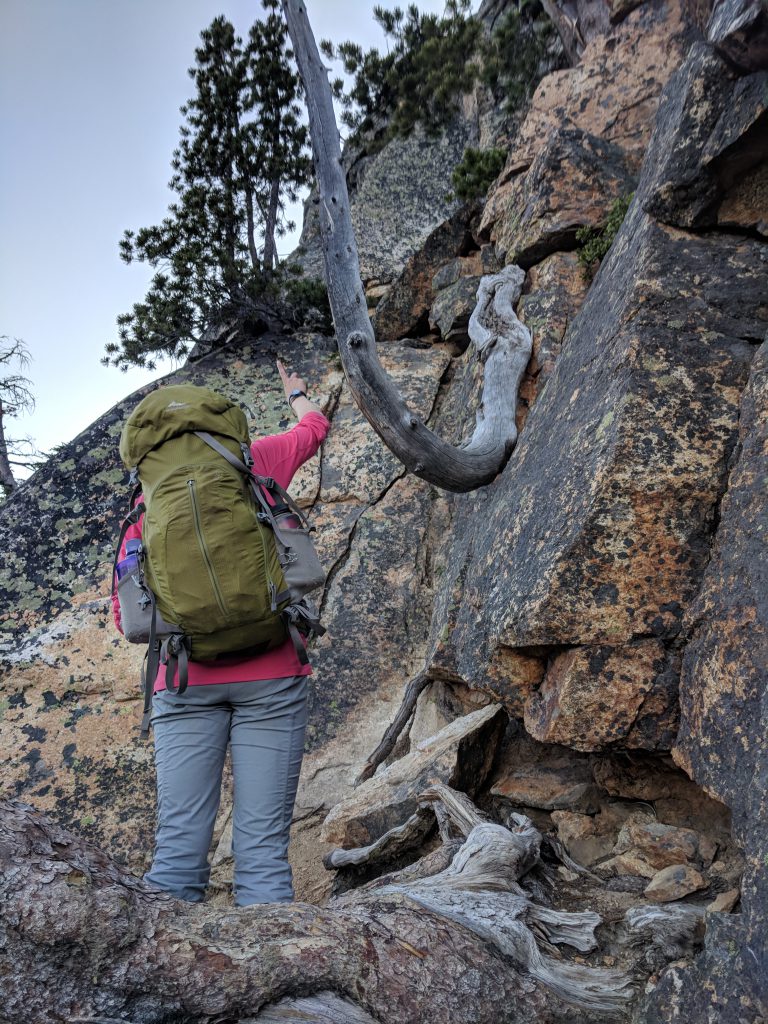
But since it looked easy enough, and there was a definitive ledge above it (and we didn’t know where the official pitch starts, and everything leading up to this had similar class 4 scrambling), we decided to scramble up it. That scramble went fine.
Once on the ledge, there were several choices of cracks and routes.
Attempting the cracks
There are two crack options at this point – a wide off-width crack to the left, or a hand/fist sized crack on the right. Once again, there’s no photos of this on Mountain Project, but apparently people climb both. Consensus seems to say the crack on the right is the correct one.
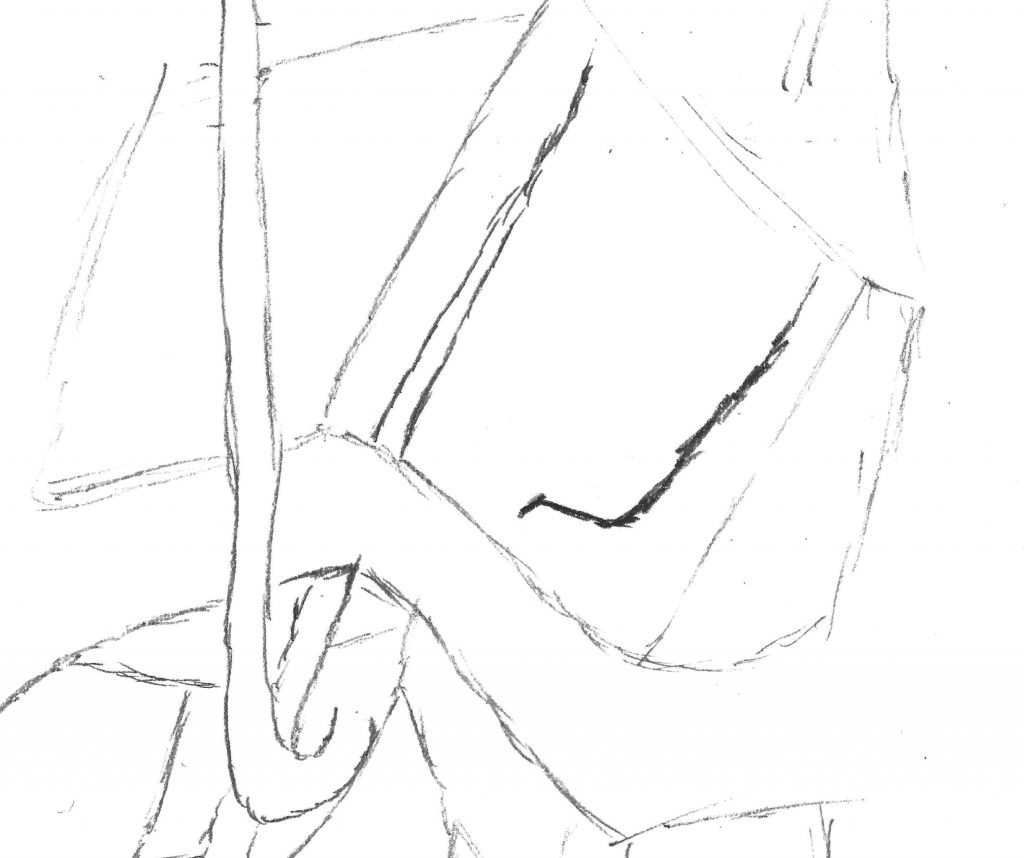
Alexis tried the left crack first (seen below from Dandelion’s blog), but due to the awkward off-width, it seemed hard to protect and more difficult than just a 5.7.
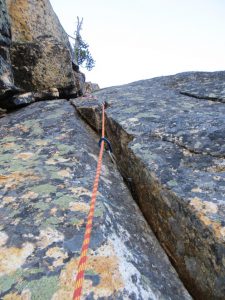
Since we saw some other crack options, Alexis downclimbed back to the ledge, and we moved over to the more parallel hand/fist sized crack to the right (not seen in the photo).
This right crack took gear a lot easier, but it was similarly a bit awkward to climb (granted neither of us are crack fans).
Alexis was about 10 feet up the crack when it was becoming difficult, so rather than continuing and potentially getting into even tougher unknown climbing, we decided that we should look at some other options (it seemed like you could walk around even further to the right, so maybe we weren’t on the route).
So Alexis started downclimbing again. She had two cams in at this point. But then we made our mistake… She reached her last cam and took it out, and was only at most 4 feet above our ledge. But little did we know, it was a large awkward step down, and the ledge was smaller than we thought.
The fall
I (the belayer) was standing to the right and close to Alexis. Alexis was struggling with the final step down. I tried to assist with my left hand behind her back as she made the step down.

Then suddenly, something happened – maybe she lost balance as she was trying to step down, or maybe she stepped down but her foot slipped on the sloping gravel on the ledge. It all happened too fast that we don’t remember exactly what happened.
All I think I know happened was that she likely ended up leaning/falling to the left. I tried holding her with my left arm, but it was a futile effort.
Then came our mistake: Since we were on the “first pitch” and on a “flat ledge”, we hadn’t anchored me (the belayer) in anywhere. So we had zero protection and anchors. We weren’t connected to the rock. We made a mistake and failed to realize that we should have been treating this as a multi-pitch scenario, in case someone falls below the “ground” of the first pitch. We’ve seen other climbers make this mistake (and done this ourselves) on other climbs, especially where we believed the climbing to be fairly easy, but hadn’t thought much of it.
We both went tumbling down. Initially I might have still been trying to hold Alexis, but with about 5 feet of rope slack between us, and the MegaJul auto locking belay device in use, we were a connected duo either way.
We fell back down the 10 foot class 4/5 scramble and rolled a tiny bit more, and miraculously managed to stop just beneath that ledge, on a 30 degree downslope dirt slope.
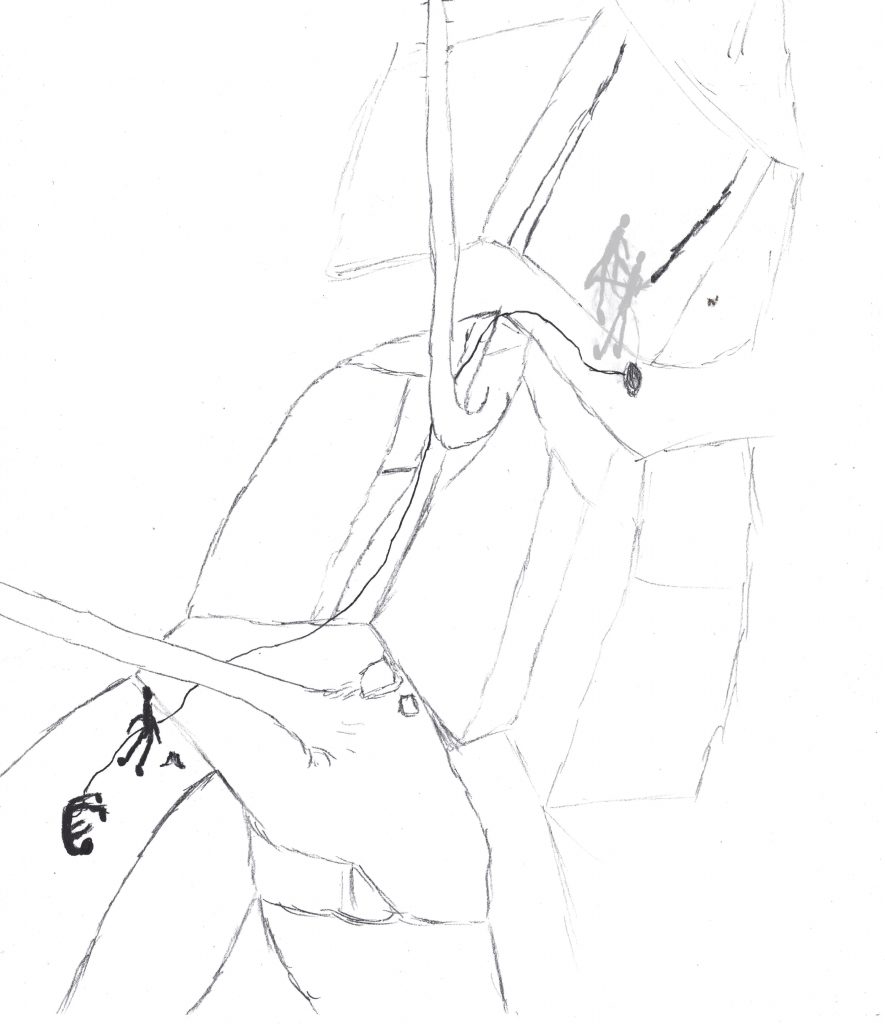
Alexis was a few feet below me, upside down, with her legs above her head. Her leg might have possibly caught around a small adjacent tree, which might have been what prevented her from rolling any more. She looked like she was about ready to continue rolling though. If we had gone any further, it would have been a 50 foot drop after that.
Our mistakes and learnings… No one ever expects to be the one who makes a mistake, but we all eventually make mistakes…
- Downclimbing: Simply leave the last piece in and either lower from it, or downclimb beneath it even if the ledge below looks stable. Maybe we could reach the cam once on the ground. If not, we could re-climb back up to it, placing tons of cams beneath, so that as you do downclimb, you have another cam beneath you every few feet. Or, even though it’s a difficult decision, just leave a piece behind – it’s not worth your life.
- Awareness of potential of falling beneath the “ground”: Before we started climbing, we should have analyzed the ledge we were starting from… it was slanting, and gravely – a.k.a. we could fall beneath it, we’re not actually on the ground. Therefore, either anchor the belayer in or instantly put a piece in before climbing, to prevent an infinite fall.
- Spotting the climber: When the climber isn’t clipped in, the belayer should be spotting (something I rarely see climbers do). I often try to be on top of my spotting game, but this time I wasn’t doing a great job – I wasn’t directly behind the climber, in a position where I could rotate their body upwards rather than letting them fall back. Had I been in that correct position, I probably would have realized “whoa, there’s not much room left on this ledge…” and that would have made me pause and probably recommend lowering from a piece. But instead, I was to the right of Alexis, where there was more ground space, but that wasn’t where she was going to fall.
But unfortunately, as with all mistakes, we made decisions that, in hindsight, weren’t the best. We always knot the rope while rappelling, we carefully inspect slings on anchors and replace when worn, etc. However, no one is perfect, and mistakes are inevitable. Mistakes are often only discovered when something unplanned happens, and then you realize that what you had been doing was actually unsafe. Our hope is that others can learn from these mistakes, just like I’m personally reading up on other climbing accidents to learn about other mistakes I would never think about.
Getting secure
After we stopped falling, Alexis hadn’t said anything since we landed where we were, so I called out her name. She didn’t respond. “Alexis!” I said again. A tiny mumble comes out. “Alexis!” Some more mumbles come out.
From the mumbles, I know she’s at least alive.
I look around and assess the situation. We’re still on a downslope and Alexis looks like she’s about ready to keep tumbling down, especially if she moves at all.
I need to get us anchored so that we don’t fall any more. Right next to me, there’s a small tree stump. I take the rope between us and coil it around the tree stump to quickly provide an anchor while I think some more. It will hopefully hold with the friction of the rope wrapped around it three times.
Now I look around for a better anchor. I need to get Alexis upright and we need to get off of this downslope.
About 6 feet above me, there’s a large tree. If I can get to it and sling it, that’ll be a bomber anchor, and then I can help get Alexis up there.
I feed out more slack for myself using my MegaJul belay device, while checking that the rope is still decently wrapped around the temporary tree stump anchor, and then I stand up.
My leg felt a bit sore, so I decided to pull up the shorts on my left leg. There’s a large bloody gash in it. “This doesn’t matter right now”, I think to myself, “we first have to get anchored and safe. If we stay here, we’ll roll off and we’ll be dead no matter what.”
So I walk up to the tree, and start deciding what to sling it with. I try seeing if my pre-sewn double length sling would fit around the tree, but it doesn’t, so I’ll have to tie a sling. I grab my webbing coil from my harness and start tying the water knot around the tree.
As I’m tying, my vision starts to black out. I shouldn’t have looked at my cut! I bet that wouldn’t have happened if I didn’t know I had a cut. But I force myself to concentrate, breathe, and finish tying the knot.
Then I clip my personal anchor into the newly created bomber anchor. We’re safe from absolute death. If my temporary anchor failed below, my MegaJul belay device would catch Alexis (pulling on me, but I’m anchored in).
Now I need to get Alexis up here with me, somewhere more comfortable than upside down on a slope. Luckily, there’s a nice flat ledge right beneath my new tree anchor.
I forget exactly what I did next… I think I put the rope through a carabiner attached to the anchor, as if it’s a top rope setup, and then I walked down to Alexis (with the belay device still attached to me), letting out slack to reach her (but therefore still keeping the system tight so that if either of us fell, we wouldn’t fall anywhere). Or possibly I was able to reach her with my personal anchor chord. Tough to remember.
Once I reached Alexis, I tried talking to her a bit more. This time she was constantly repeating “my wrist is broken”, “my teeth are broken” (that’s called perseverating). I told her we have to get her upright and up to the ledge. I considered the concern of spinal injuries, but in the risky position she was, I decided she had to be moved regardless – help would be hours away. I started pulling her upwards from the back of her backpack, in an attempt to rotate her onto her feet. Luckily, she was somewhat assisting, and after about 30 seconds, I eventually got her upright. And then I helped her walk up to the ledge, and laid her down on the nice flat ledge. As we walked up, I was taking in the slack between us. This is where the MegaJul auto locking came handy once again… otherwise I’d constantly need a hand on the break, or I’d need to set up a top belay, which would take more time. After laying her down on the ledge, I clove hitched her rope into the anchor, and placed an extra pack under her head. We were finally comfortable and secure.
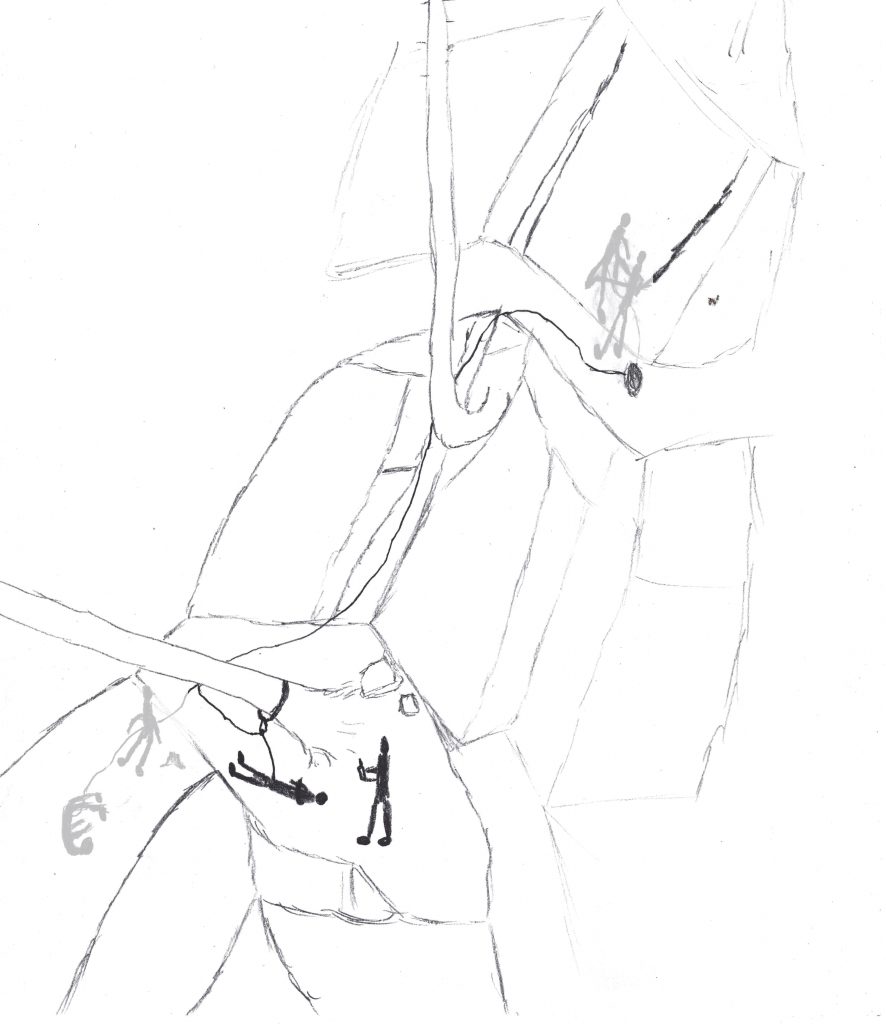
Calling for help
Now that we were secure, I needed to figure out how we were going to get out of here. I took another look at the cut on my leg. Somehow it wasn’t bleeding. It seemed pretty deep, but apparently not deep enough! That’s good! That would have been a pain to deal with.
Alexis was constantly repeating “my wrist is broken”, “my teeth are broken”, “what happened”? She was clearly concussed (didn’t have to have any special training to figure this one out). But thankfully, I knew her main injuries – broken wrist, concussion, and broken teeth.
As for my injuries, it seemed difficult to walk on my leg, but the cut wasn’t bleeding. Maybe I had a slightly broken thigh bone?
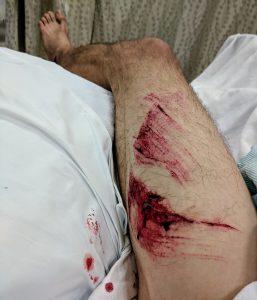
Considering the trail back down is an hour of class 3-4 scrambling with probably three sections that one would rappel in normal uninjured conditions, there was essentially no chance we would be able to get down the trail by ourselves.
Therefore, I decided to use the Garmin InReach SOS. But first I had to get to the device… which was in Alexis’ backpack… which she was laying on comfortably on the ledge… And I also didn’t know what pocket it was in… and Alexis wasn’t in a state where she could tell me.
It took a while, but I finally found it inside a bag inside her main pack.
I activated SOS mode and sent the following messages…
Me (7:13 AM): I have an emergency, and I need you to send help. Broken wrist concussion cut on leg. 2 climbers injured.
Me: Walkie talkie channel 1. 1. At base of first pitch. Suspect broken leg.
Garmin: (7:35 AM): Emergency Response acknowledged your emergency.
Garmin: (7:36 AM): This is the IERCC, we have received your SOS activation. What is the nature of your emergency?
Me: (7:38 AM): Need pack out cannot walk both climbers
Garmin: (7:41 AM): What are the names/ages of injured climbers?
Garmin: (7:42 AM): Emergency services have been made aware of your activation and are working to get to your location. We do not have an ETA at this time.
Me: (sent names and ages)
Me: (8:32 AM): Any update
Garmin: (8:40 AM): We just got off the phone with the assigned agency, they mentioned a helicopter will likely be used but did not give an ETA yet.
Garmin: (8:41 AM): What is the combined weight of the injured climbers?
Me: 265 combined weight plus 30 lbs gear
10:10 AM: Helicopter arrived
11:00 AM: Helicopter hoisting me up (and then Alexis)
It took a long time for the messages to actually send. I tried walking around the corner of the ledge (which was difficult, since my leg was starting to hurt more and couldn’t really bear any weight). I started to scan channels with our walkie talkies, to see if anyone would pick up, in case the GPS fails to work. Someone actually responded on channel 1.1, but they were just some other climbers on a different peak.
After about 15 minutes, the message finally sent!
During this time, Alexis was still not fully conscious, repeating the same questions over and over again. I figured I should check her for any other potential hidden injuries, so I pressed on her back/spine and legs as I’ve seen others do, but luckily there weren’t any hidden injuries or spinal injuries.
About 30-40 minutes after the initial fall, Alexis finally started to become coherent again. Her first questions were “Are we married?” and “Is it after the fourth of July?” It’s interesting the questions your brain thinks of when it first comes back online! She was very confused as to what happened, and it took her a while to understand that we had fallen.
I had a SAM splint in my first aid pack, but hadn’t put it on Alexis’ wrist yet, since I wasn’t very confident in my splinting skills. Once she was conscious, I asked her whether she wanted me to put it on. Luckily, I had one of these splints put on myself, when I broke my wrist, and I’ve also seen other people practice putting them on, so I had a decent idea what I was doing, and I put it on decently well. It probably would have been better to put the splint on while she was still semi-unconscious so she didn’t have to experience as much discomfort, but my lack of confidence in my first aid skills meant that I wanted to wait to have a second opinion when placing the splint.

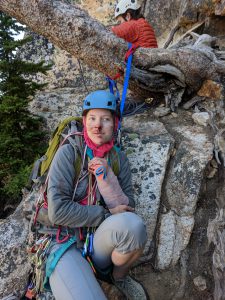
Before the fall, we saw another group arrive at the trailhead (you can see the road/trailhead from the cliff), and this group finally reached us at this time.
They were a group of 4 with one person that was ex-marine. He helped wrap my leg gash (I postponed this since I was busy with other things, and it wasn’t actually bleeding), and they gave some energy goo snacks to Alexis which were great since she couldn’t eat with her teeth.
After some more time, we got a response that helicopter will likely be coming, but no ETA.
The other group decided to send down two of their people to communicate with any help that came to the road. We gave them our second walkie talkie (we’ve been using walkie talkies on rock climbs, they work so much better than yelling!), so that we could communicate with them.
After more time, they arrived at the cars, where the sherrif arrived moments ago. They either used our radio or the sherrif’s radio to communicate with us, which was so helpful. They told us that a helicopter would be coming overhead in 10 minutes.
The Navy helicopter from Whidby Island came in and dropped one person to come check us out. They then dropped another person after the first person requested another.
They were classic Navy men, large, built, certainly makes you feel safe.
They rigged the backpacks up to haul, and then took me up in the stretcher (due to concern about my leg), and finally Alexis up in the chest harness.
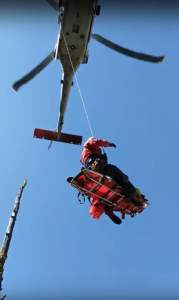
The helicopter was noisy as ever, but it was so quick getting to UW Hospital! Maybe like 40 minutes! I never want to do that 3:30 hour drive again!
In the hospital, we found out that Alexis broke her larger wrist bone. I actually didn’t break my leg, just severe muscle bruising (and later I found out that my knee also probably had some ligament/tendon damage, possibly the meniscus). For the first few days, I could hardly bend my knee.
Being thankful
Looking back on everything, all we can really say is that we were thankful for all the good luck that we had. We’re thankful we managed to stop falling before the 50+ foot cliff. We’re thankful the weather was clear and a helicopter could come rescue us. We’re thankful the group of 4 was able to help us by standing by our sides and keeping us company. We’re thankful that group were able to drive our car back to Seattle for us. We’re thankful that we have excellent health insurance, so that finances were never a concern when going to the hospital. We’re thankful that Seattle has a great trauma hospital. We’re thankful that we don’t have any permanent injuries!
Learning lessons
As with everything, there are so many lessons to be learned.
We did a lot of things right…
- We had a two-way communication PLB (Garmin InReach) so we could send SOS outside of cell reception. Communicating with SOS services (telling them our injuries, etc) is critical, way better than a one-way device that can’t send messages.
- We had a quality first-aid pack. I was able to splint Alexis’ wrist. If my thigh cut had been deeper, I had deep tissue wound supplies, even a quick-clot pack.
- We had walkie-talkies, great for communicating with local emergency services.
- We both had experience improvising with anchors/belay systems, etc (knew how to improvise when shit went south). That meant I was able to safely get us secured after the fall. If I needed to use a mechanical advantage 3:1 or greater, I could.
- I knew how to apply a wrist splint and I knew signs of concussion.
We obviously made mistakes…
- Not realizing we were on a small “multi-pitch” ledge for our first pitch (the most dangerous mistake which could have killed us)
- Downclimbing mistakes
- Not properly spotting the climber
- Looked at injury before getting safe/secure – I almost passed out while I was rigging our bomber anchor since I had looked at my gash on my thigh before hand. First get secure, then look at injuries, in case they make you pass out!
- Not both knowing where the Garmin InReach was (I had to search for a while)
And there were some mistakes that didn’t have significance this time, but could have in different circumstances…
- My first-aid pack lacked a triangle wrap. If we had to walk out, that would have been nice to stabilize a broken wrist against the chest.
- My first-aid pack lacked some nice medical tape. If we had to tape up some bandages, I didn’t have anything for that.
- We hadn’t told our family where we were climbing or when to expect us, so if we hadn’t been able to use the Garmin (maybe it broke, maybe we lost our backpacks), we could have potentially been stranded if another group didn’t show up.
- My first-aid knowledge is very limited. Had injuries been worse, I might have not been able to help.

